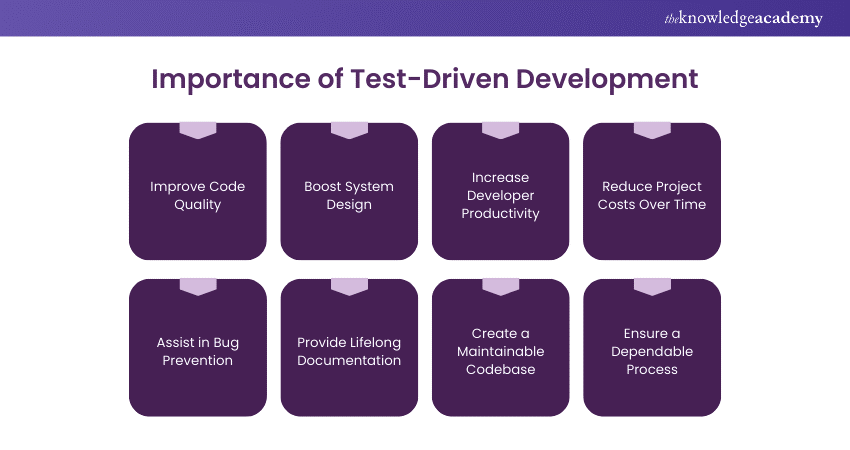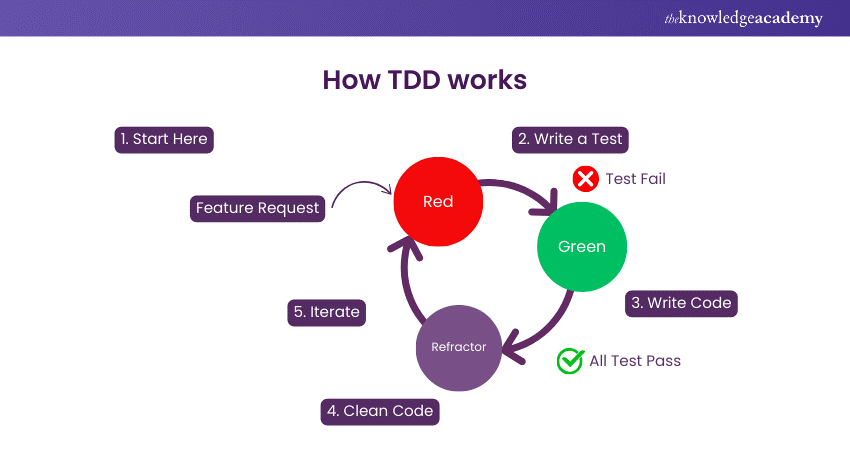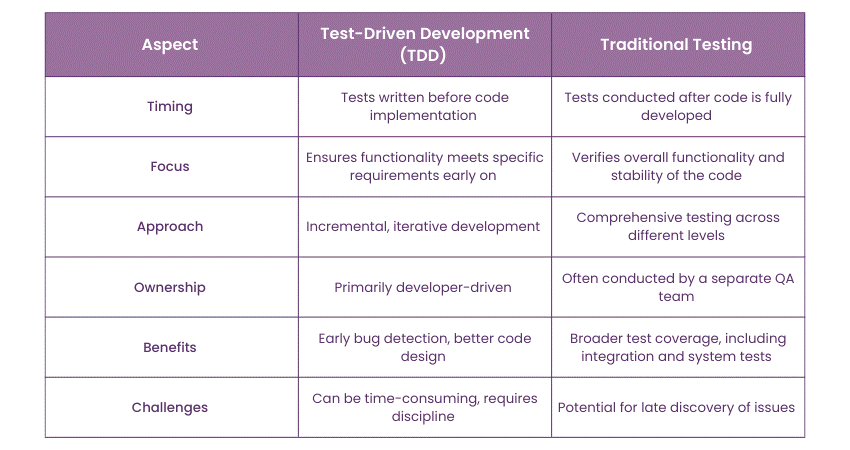We may not have the course you’re looking for. If you enquire or give us a call on 01344203999 and speak to our training experts, we may still be able to help with your training requirements.
Training Outcomes Within Your Budget!
We ensure quality, budget-alignment, and timely delivery by our expert instructors.

Imagine releasing a software product only to discover critical bugs after launch. Traditional testing methods often fall short in preventing such disasters. Test-Driven Development offers a proactive approach. By writing tests before code, TDD ensures code quality, improves design, and accelerates development.
Let's delve into the world of Test-Driven Development, exploring its principles, benefits, and best practices. Discover how this methodology can revolutionise your Software Development process.
Table of Contents
1) What is Test-Driven Development?
2) Importance of Test-Driven Development
3) TDD Versus Traditional Testing
4) TDD Software Testing Limitations
5) TDD Software Testing Best Practices
6) TDD Versus Traditional Testing
7) Conclusion
What is Test-Driven Development?
In simple terms, Test-Driven Development (TDD) is a software development methodology where unit test cases are written before the actual code is implemented. This process flips the traditional approach to coding on its head, ensuring that the code meets the expected outcomes from the very start. By doing so, TDD fosters a continuous feedback loop that helps developers stay aligned with the requirements and makes debugging simpler and more efficient.
TDD has its roots in the Agile Manifesto and Extreme Programming (XP), two methodologies that emphasise flexibility, collaboration, and customer satisfaction in software development. The principles of TDD are designed to make the testing process an integral part of development rather than an afterthought.
By writing tests first, developers are forced to consider the software’s requirements and design from the user’s perspective. This approach minimises bugs, reduces the need for extensive debugging later in the development cycle, and ensures that the codebase remains robust and adaptable to change.
Importance of Test-Driven Development
Test-Driven Development is crucial for several reasons, benefiting DevOps teams in the following ways:

Improve Code Quality
Developers must define their goals for the code before writing tests, ensuring higher quality and fewer errors. TDD encourages the creation of simple, extensible code by promoting routines that lead to better code automatically. It also allows developers to focus on shorter, more readable sections of code, making it easier to meet test requirements.
Boost System Design
Writing tests before production code allows developers to address boundary cases more effectively. TDD focuses on one small aspect at a time, resulting in simpler, more straightforward interfaces. This approach leads to a modular, easy-to-understand, maintainable, expandable, testable, and refactorable application structure with fewer errors and flaws due to extensive testing.
Boost your testing skills by Signing up for our ISTQB Software Testing Foundation Course Today!
Increase Developer Productivity
TDD speeds up development by reducing debugging time. Although it may take longer to create tests and production code initially, adding and testing new functionality becomes faster and requires less rework as the project progresses. A Study by Microsoft and IBM found that TDD reduced defect density by 40–90%, with project completion times increasing by 15–35%, offset by lower maintenance costs due to improved quality.
Reduce Project Costs Over Time
TDD significantly lowers project development costs by eliminating potential flaws and making code maintenance more manageable. The benefits of TDD lead to reduced costs and improved team performance. While TDD may be more expensive in the short term due to increased testing, the long-term cost savings are substantial.
Assist in Bug Prevention
TDD ensures complete test coverage, making it easier to catch defects before they occur. Developers focus on writing tests to prevent defects rather than fixing them after code development. Comprehensive test suites built with TDD reduce the likelihood of undetected defects, ensuring the application functions as intended with minimal fixes.
Provide Lifelong Documentation
Tests serve as documentation for developers, outlining how to use classes and establishing test scenarios in a common language. This documentation enhances developer understanding of the system, supporting common code ownership and allowing any developer to make code changes.
Create a Maintainable Codebase
The TDD process includes refactoring, which optimises existing code for readability and implementation. Developers can refactor code to meet standards if it passes initial tests, following a cycle of adding new tests, running them, creating code, testing, reworking, and repeating. This approach ensures maintainable and effective code.
Ensure a Dependable Process
TDD provides confidence in the reliability of the developed solution. Tests help verify that everything works as intended after refactoring or introducing new features. Without TDD, developers may lose track of current developments and be unsure how new software interacts with existing code. TDD supports Agile Development, allowing developers to focus less on the consequences of future changes.
Transform your career with our Agile Software Testing Course —Register today!
TDD Software Testing Process
The TDD process is often explained using the Red/Green/Refactor cycle. Let’s break it down:

1) The Red Phase
In this phase, developers create a test for the behaviour they intend to implement. This is challenging because the test is written against non-existent code. Developers need to shift their mindset to think about what to test as if the code already exists. The focus should be on designing a user-friendly interface for the future.
Initially, the test won’t compile without the necessary class and function declarations, leading to a failed test. Running the test at this stage will result in compile errors, hence the name “Red Phase.” Decisions about code usage are made based on actual needs, not assumptions.
2) The Green Phase
The goal here is to write just enough code to pass the initial test without worrying about the best implementation. This phase is typically the easiest as it involves writing the minimal code required to make the test pass. Developers compile the code and run the unit tests. The concept of writing “just enough” code can be a hurdle for TDD newcomers.
Once the first test passes, developers write the next failing test and add code to make it pass. The focus is on creating a simple solution to pass the test, even if it means using duplicate code or ignoring industry standards temporarily. This phase ends when the developer is “in the green,” meaning all tests pass.
3) The Refactoring Phase
In this phase, developers improve the code while ensuring all tests continue to pass. The initial goal was to make the tests pass, but now developers can enhance the code with a better understanding of the problem. Refactoring focuses on design patterns, code maintainability, readability, and quality. The test suite acts as a safety net, ensuring nothing breaks during refactoring.
This phase showcases the developer’s skills to others who will read the implementation. The test suite is continuously updated to reflect the project’s progress and the current state of the production code. Developers don’t need to worry about losing functionality during refactoring, as test cases will automatically verify functionality with each code modification.
Unlock your potential with the Certified Software Testing Professional Certification—Start your journey with us!
TDD Software Testing Limitations
While TDD offers many benefits, it’s important to be aware of its limitations:
1) Slows Down Initial Development
TDD can initially slow down development because tests must be written before the code. This can be time-consuming, especially in a rapid iterative startup. If you’re under tight deadlines to launch a product or service, TDD might not be the best approach as it requires time to build tests first, potentially delaying the implementation code.
2) Maintenance and Support Challenges
One of the significant drawbacks of TDD is the need to modify tests to accommodate changes in product requirements. This can be costly and impact schedules significantly. As projects grow, maintaining numerous unit tests becomes more challenging, especially since many conventional unit tests are closely tied to specific code implementations.
3) Steep Learning Curve
Adopting TDD can be difficult for teams unfamiliar with its concepts. Learning TDD on one’s own can be challenging, requiring a high level of commitment and a desire to improve continuously. It’s easier to adopt TDD in the early stages of a project with a simpler architecture, but it can interfere with time and resource allocation for more advanced projects.
4) Complexity in Understanding TDD Code
Writing code correctly is different from just writing code, making TDD code sometimes hard to understand. TDD focuses on code coverage, which doesn’t necessarily reflect the quality of the code. Creating effective unit tests is an art form, and many managers focus on metrics like code coverage, which may not correlate with the quality of the unit tests.
5) Rigidity of the TDD Approach
TDD can seem daunting initially, as it requires developers to focus on one thing at a time and write tests before looking at the code. Developers must keep up with maintaining and refining tests to ensure they run efficiently. The TDD methodology can affect code planning, and for it to be effective, every team member must understand and follow its principles.
Master unit testing fundamentals—Sign up for our Introduction to Unit Testing Course today!
TDD Software Testing Best Practices
Test-Driven Development is a Software Testing approach where tests are written before the actual code. To make the most of TDD, the following best practices are essential:
Structure and Arrange
Organise your tests using the Arrange-Act-Assert (AAA) pattern. This structure improves readability and ensures that each test focuses on a single aspect of the code. Arrange the necessary data, execute the function, and then assert the expected outcome.
Regular Refactoring
Continuously refactor both your tests and code. TDD is iterative; as your understanding of the problem grows, refining the code and tests keeps everything clean and maintainable.
Ensure Clarity and Completeness
Tests should be clear and comprehensive, covering all possible scenarios, including edge cases. Clear tests are easier to maintain and help others understand the code.
Write Atomic Tests
Each test should be independent and focused on one specific behaviour or feature. Atomic tests reduce complexity, making it easier to pinpoint issues when they arise.
Automate Your Tests
Automated tests save time and reduce errors. Integrating automated testing into your CI/CD pipeline ensures that tests run consistently without manual intervention.
Continuously Run Tests
Frequent testing helps identify issues early, preventing small problems from escalating. Continuous testing is integral to maintaining a stable and reliable codebase.
Optimise your software lifecycle—Register for our Application Lifecycle Management Testing Training now!
TDD Versus Traditional Testing
Test-Driven Development and Traditional Testing are two different approaches to Software Testing, each with its own strengths.
TDD is a methodology where developers write tests before writing the actual code. This approach emphasises writing small, incremental pieces of code that meet the requirements of the tests. The process follows a cycle: first, a test is written based on the requirements; then, code is written to pass that test; finally, the code is refactored for optimisation. TDD helps in creating a robust and well-tested codebase from the outset. It also encourages good design practices and keeps the focus on delivering functional code that meets specific requirements.
On the other hand, Traditional Testing typically occurs after the code has been written. In this approach, testing is often carried out by a separate QA team. The code is tested against predefined test cases to ensure it meets the specifications and works as expected. Traditional Testing can be more comprehensive, as it allows for broader test coverage, including integration, system, and acceptance testing.
While TDD emphasises early bug detection and iterative development, Traditional Testing provides a more thorough examination of the entire system. Choosing between the two depends on the project’s needs, team structure, and development methodology.

Conclusion
Test-Driven Development is a powerful methodology that enhances code quality, reduces bugs, and ensures that software meets its intended requirements. By integrating testing into the development process, TDD promotes cleaner, more reliable code, ultimately leading to more robust and maintainable software solutions.
Master Advanced Testing Techniques—Become a Software Testing Black Belt Today!
Frequently Asked Questions

TDD is not always used because it can be time-consuming, requires strong discipline, and may slow down the initial development phase. Some teams may also lack the necessary skills or see it as unnecessary for certain projects.

TDD can technically be done manually, but it's impractical and inefficient. The process involves frequent testing and refactoring, which is better suited to automation tools that quickly execute tests and provide immediate feedback.

TDD is not mandatory in Scrum, but it can complement Scrum's iterative approach. Scrum focuses on delivering increments, and TDD can enhance code quality and ensure that each increment meets the required standards.

The Knowledge Academy takes global learning to new heights, offering over 30,000 online courses across 490+ locations in 220 countries. This expansive reach ensures accessibility and convenience for learners worldwide.
Alongside our diverse Online Course Catalogue, encompassing 19 major categories, we go the extra mile by providing a plethora of free educational Online Resources like News updates, Blogs, videos, webinars, and interview questions. Tailoring learning experiences further, professionals can maximise value with customisable Course Bundles of TKA.

The Knowledge Academy’s Knowledge Pass, a prepaid voucher, adds another layer of flexibility, allowing course bookings over a 12-month period. Join us on a journey where education knows no bounds.

The Knowledge Academy offers various Software Testing Courses, including the E ISTQB Software Testing Foundation Course, the Software Testing Black Belt and Software Testing Green Belt Courses. These courses cater to different skill levels, providing comprehensive insights into Software Unit Testing.
Our Business Analysis cover a range of topics related to Test-Driven Development, offering valuable resources, best practices, and industry insights. Whether you are a beginner or looking to advance your Software Testing skills, The Knowledge Academy's diverse courses and informative blogs have got you covered.
Upcoming Business Analysis Resources Batches & Dates
Date
 ISTQB Software Testing Foundation
ISTQB Software Testing Foundation
Mon 6th Jan 2025
Mon 3rd Feb 2025
Mon 17th Feb 2025
Mon 3rd Mar 2025
Mon 17th Mar 2025
Mon 31st Mar 2025
Mon 28th Apr 2025
Mon 19th May 2025
Mon 2nd Jun 2025
Mon 16th Jun 2025
Mon 30th Jun 2025
Mon 14th Jul 2025
Mon 28th Jul 2025
Mon 11th Aug 2025
Mon 8th Sep 2025
Mon 22nd Sep 2025
Mon 6th Oct 2025
Mon 20th Oct 2025
Mon 3rd Nov 2025
Mon 17th Nov 2025
Mon 1st Dec 2025
Mon 15th Dec 2025







 Top Rated Course
Top Rated Course



 If you wish to make any changes to your course, please
If you wish to make any changes to your course, please


